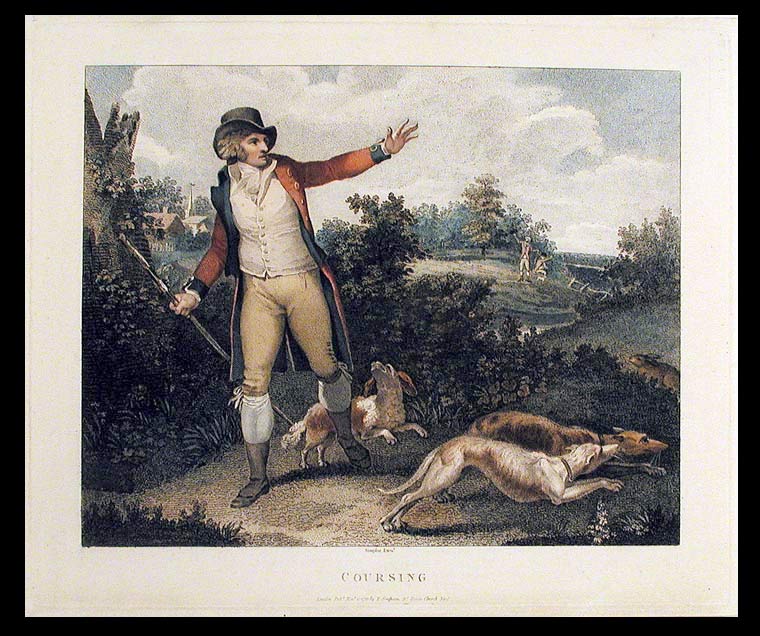[IBBETSON, After Julius Caesar (1759-1817)]
Coursing
London: T. Simpson, 10 November 1791. Stipple engraving, printed in colours and finished by hand, by Robert Dodd. Image size (including text): 11 5/8 x 14 1/2 inches. Sheet size: 14 3/4 x 17 5/8 inches.
A dramatic image of a regency buck releasing his hounds after a hare
Only the publisher is certain on this print. Siltzer records Simpson as having published a series of six plates after Ibbetson in 1790, but with the 'Coursing' plate in aquatint by Simpson himself. The remaining five are listed as being stipple engravings by Dodd. The present image is the correct size, and the engraving method is uniform with the other five by Dodd. All this suggests that this may be a proposed replacement for the earlier aquatint and should therefore be viewed as a companion piece to the other Dodd prints. Julius Cæsar Ibbetson "was apprenticed to John Fletcher, a ship-painter at Hull. Ibbetson attracted public attention by his designs for ship decoration and by some scenery painted for the Hull Theatre, and his success encouraged him to seek his fortune in London in 1777. He was forced at first to work for Mr. Clarke, a picture dealer in Leicester Fields, but was able at the same time to acquire a thorough acquaintance with the works and methods of Dutch artists, besides learning all the tricks of the trade... In 1780 he married... In 1785 he exhibited at the Royal Academy A View of Northfleet, and continued to exhibit during succeeding years. Becoming acquainted with Captain William Baillie and others, he was introduced into good society, and was patronised by the nobility. In 1788 he accepted a post in Colonel Cathcart's embassy to China. Cathcart, however, died at Java during the voyage, and Ibbetson returned to England. He made many drawings during the voyage, and obtained nautical experience, which he afterwards turned to account in his pictures, but was not able to obtain any remuneration on his return... He sought relief from his misery in dissipation and convivial society, after the example of his friend, George Morland... This only led to further embarrassments, and in 1798 he quitted London for Liverpool to escape his creditors. Ibbetson lived quietly for some time near Ambleside in Westmoreland, visiting Scotland in 1800... A sign painted by Ibbetson for an inn at Troutbeck, near Ambleside, had some notoriety... He suffered further pecuniary losses through the defalcations of a friend, but the number of his commissions now enabled him to free himself to some extent from debt. At the invitation of one of his chief patrons, Mr. William Danby of Swinton Park, Ibbetson settled near that place in Masham, Yorkshire. Here he spent the remainder of his days... As a painter in oil of cattle and pigs Ibbetson has hardly been excelled in England, even by Morland... In his landscape-painting Ibbetson somewhat resembled Richard Wilson, R.A. He also painted small portraits in a neat and rapid manner. His paintings of animals were much prized, especially in Yorkshire, where they are often to be met with in private houses. Benjamin West called him the Berghem of England. He also painted in water-colour in the old tinted method with great success." (DNB).
Item #5340
Price: $2,250.00


